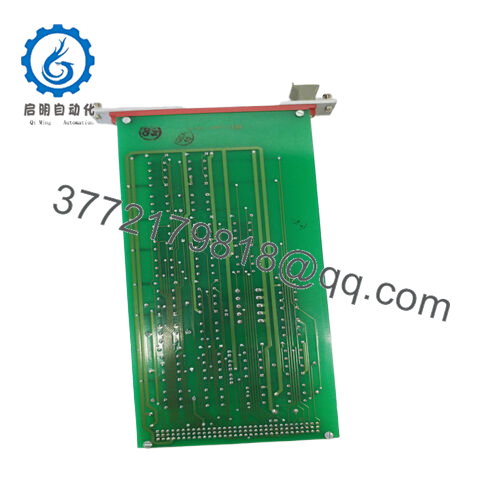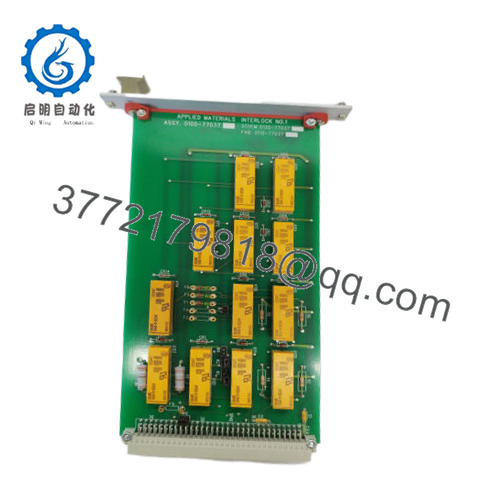Description
What This Product Solves
In the precision-engineered world of semiconductor fabrication and industrial process control, ensuring airtight safety interlocks between vacuum chambers, gas manifolds, and high-voltage electrodes is paramount—particularly in Applied Materials (AMAT) platforms like the Centura etch clusters or Endura deposition tools, where a single unmonitored door cycle or pressure breach could expose operators to hazardous RF fields or toxic byproducts, triggering emergency vents that idle multi-million-dollar tools for hours and cascade into yield-impacting downtime in fabs racing toward 3nm production. These risks compound during tool handoffs or maintenance windows, where legacy interlock boards falter under ESD events or sensor drift, spawning false trips that halt wafer flows or, worse, overlooked faults that breach SEMI S2 safety protocols, inflating compliance audits and repair costs in environments where human safety and process purity are non-negotiable.
The Applied Materials 0100-77037 addresses this as an ASSY Interlock PCB Module, a robust safety sentinel designed to monitor and enforce interlocking logic across AMAT’s process modules, guaranteeing fail-safe states without the intermittent latching that plagues generic relay cards. It becomes indispensable in retrofits for Producer PECVD systems or Ultima CVD chambers, where modular integration requires plug-in assemblies that sync with Synergy controllers without rewiring safety loops. For engineers confronting high-reliability challenges in industrial automation for wafer processing, this PCB intervenes when standard PLC I/O can’t resolve microsecond door signals or gas interlocks amid plasma noise, delivering the signal isolation that preserves I/O integrity in EMI-saturated subframes.
Envision a reactive ion etch step where the interlock must verify chamber seals and exhaust flows before igniting 2kW plasmas, or a PVD sputter where target bias holds until vacuum integrity confirms—the Applied Materials 0100-77037 excels, embedding opto-isolated inputs and latching relays that trip on anomalies like overpressure, averting exposures while enabling quick resets. In these semiconductor process control crucibles, it curtails the debug drag of safety chain audits, piping status to the tool HMI for at-a-glance compliance. At its essence, this assembly redefines interlocks as proactive guardians, not reactive relics—fostering the operational security and uptime that underpin defect-free runs, while streamlining the path to scalable safety fabrics in your fab’s high-stakes evolution.
- 0100-77037
How the Product Works & Fits into a System
The Applied Materials 0100-77037 functions as a dedicated safety arbiter in AMAT tool architectures, scanning up to 32 discrete inputs from limit switches, pressure transducers, and door sensors via opto-couplers that isolate at 2500Vrms, then driving dual-pole relays to gate outputs like solenoid valves or RF inhibits—executing interlocking sequences in <5ms with debounced logic to filter bounce from mechanical contacts, all while drawing 5V/24V from the backplane to sustain through transients. It latches faults on dual-channel verification, requiring manual acknowledgment via a keyed reset, and communicates status over RS422 to the Synergy SBC for recipe halts or log entries, ensuring SEMI-compliant e-stops propagate without false positives.
Positioned in the safety I/O layer of your tool’s electrical stack, it mounts via standoffs in the subrack enclosure, interfacing with the VMEbus controller upstream and field wiring downstream via Phoenix connectors for up to 100m runs on shielded pairs—ideal for redundant loops where mirrored PCBs vote on critical paths, failing safe on mismatch to prevent single-point overruns. Protocol handling includes AMAT’s proprietary safety dialect with Modbus echoes for fab MES, configurable through the tool console to map interlocks to process phases like pumpdown or vent.
Diagnostics are overt: tri-state LEDs for input states and relay health, plus a test coil for bench validation that simulates faults without live hazards, feeding codes to the HMI for audit trails—no multimeter marathons needed. In a complete architecture, it flanks power entries upstream and effector drivers downstream, weaving a vigilant veil for hazard-free execution—like in a Centura etch where it sequences lid clamps before gas admission, interlocking with exhaust monitors to block purges. For an Endura retrofit, the Applied Materials 0100-77037 would oversee sputter door cycles, buffering ESD from wafer loads to keep bias off until seals confirm. This seamless slotting accelerates safety certs, casting it as the unyielding umpire in your process perimeter, blending sensor scrutiny with systemic surety for attuned, accident-averse automation.
| Specification | Details |
|---|---|
| Model Number | 0100-77037 |
| Brand | Applied Materials |
| Type | ASSY Interlock PCB Module |
| Input Voltage | 5 VDC / 24 VDC |
| Operating Temp Range | 0°C to 50°C |
| Mounting Style | Standoff / Subrack Mount |
| Dimensions | 6.5 x 4.5 x 0.8 in |
| Weight | 0.4 lb |
| Interface/Bus | RS422 Serial / Discrete I/O |
| Compliance | SEMI S2/S8, CE, UL, RoHS |
| Supported Protocols | AMAT Safety, Modbus |
| Typical Power Draw | 3 W |
Real-World Benefits
Opting for the Applied Materials 0100-77037 fortifies your AMAT tools with an interlock assembly precision-honed for the ceaseless vigilance of fab safety, where its dual-channel voting and 2500V isolation yield false-trip rates below 0.01%—translating to uninterrupted recipe chains that shave 1-2% off downtime in etch clusters, empowering bolder throughput without the safety buffers that conservative logic demands. This assurance isn’t ancillary; it permeates protocols, enabling automated handoffs where interlocks sync with robot kinematics to preempt collisions, distilling hazard hunts into seamless shifts across 24/7 marathons.
Safety stewards appreciate its transparent telemetry, as relay coil monitors and input debouncers surface drift in the tool log—imagine a maintenance tech tracing a sticky door switch from HMI trends, resolving pre-shift sans unscheduled vents. The assembly’s subrack compatibility lightens integration loads, with screw-terminal swaps that mate with Producer frames out-of-box, hastening requals in compliance-crushed lines where audit hours accrue. Over fab cycles spanning 5+ years, it upholds performance constancy with a MTBF exceeding 150,000 hours, its conformal-coated traces repelling HF fumes in wet benches, so your safety webs weave without the wear of recurrent relay replacements.
Deeper, the Applied Materials 0100-77037 eases extensibility by exposing aux ports for e-stops, layering in wireless beacons where interlock states fuel AR checklists—priming for smart safety where logic links to predictive maintenance on seals. These intertwined efficiencies recast interlocks from a compliance chore to a confidence cornerstone, curbing total risk costs while amplifying the resilience that anchors your semiconductor sanctuary.
Typical Use Cases
The Applied Materials 0100-77037 embeds in plasma etch tools like the Centura 5200, standoff-mounted in control bays to gate RF power on chamber lid integrity, where its 5ms response holds firm amid Cl2 flows and 500W discharges—essential for process control environments verifying exhaust before etches, upholding critical system uptime during batch loads or fault clears in 7nm logic fabs. In these corrosive crucibles, its isolation steels signal reliability, provisioning latch-free resets that dodge microtrench defects and scrap surges.
ALD platforms harness it for precursor interlocks, scanning valve positions and pressure drops under 300°C pulses and purge cycles, fostering continuous uptime where fast data cycles from flow sensors dictate monolayer precision. Harsh ALD chemistries and thermal throbs test its coatings, yet it metes out unerring gates for void-free gates.
In PVD clusters, the Applied Materials 0100-77037 oversees Endura target swaps, interlocking bias with door states over discrete loops—pivotal for used in TaN barriers where safety sync forestalls arcing and contamination creeps. Across RIE etching, atomic layer deposition, and physical vapor deposition sectors, this module vitalizes applications craving fortified failsafes in flux-fraught fields, transmuting switch states into shields of stratified security.
0100-77038 – Enhanced variant with expanded I/O for multi-chamber clusters.
0100-09145 – RS232 interlock companion for serial-synced safety in legacy tools.
0190-15779 – DC power tie-in for interlock-gated plasma supplies.
0090-76133 – Synergy SBC add-on for logic-extended interlocks.
0010-30137 – Cathode safety PCB for RF-specific interlocking.
0100-71313 – AKT series interlock for display fab extensions.
0300-76027 – Electrical sub-assembly for redundant interlock paths.
Before bolting the Applied Materials 0100-77037 into your subrack, align its DIP switch map with the Synergy config via the console—mismatch modes can orphan relays, stranding your gates open at boot. Inspect the terminal blocks for tin whiskers or flux residue from storage; a non-abrasive scrub and continuity check under 0.2Ω nixes contact chatter that mimics switch fails. Ventilation counts—leave 2U clearance in hooded enclosures to vent the 3W, particularly near heat-soaked match networks cresting 45°C—profile your input count to affirm. Pre-wire the discretes with a loop tester at 24V, confirming <1ms debounce sans bounce, and ground the shield tab solely at the frame to shunt fab ESD from ionizers.
In the cleanroom, oversight orients toward omen over overhaul. Biweekly HMI queries for latch counts—zero faults across cycles signals sentinel, but tallies tip a switch audit with a dry tester. Quarterly block unhooks with ESD sleeves and isopropyl dabs on pins exile oxide halos from humid vents; re-torque at 0.5 Nm to resist pump pulses. Annually, hammer with fault injections via the test coil to validate 99.99% trip fidelity, archiving responses for compliance chronicles. If glitches gleam, leverage AMAT’s remote status streamer over LAN, but these rhythms render the Applied Materials 0100-77037 a safeguard savant, directing diligence to divinations over dressings.



 WhatsApp: +86 16626708626
WhatsApp: +86 16626708626 Email:
Email:  Phone: +86 16626708626
Phone: +86 16626708626


